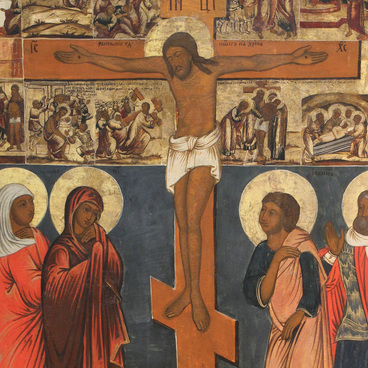The icon of Saint Nicholas of Mozhaysk from the collection of the Khanty-Mansiysk Museum of Fine Arts was created at the end of the 17th- early 18th century. The saint is depicted full-length, holding a sword in one hand and a miniature city in the other. This image of Saint Nicholas the Wonderworker, Bishop of Myra (in Lycia), was revered in memory of a miraculous rescue of Mozhaysk from an enemy attack. This iconographic type had been known in ancient Russian icon painting from the 13th century and evolved under the influence of Western tradition.
As the legend goes, Mozhaysk was saved during the Mongol invasion of Kievan Rus’. When the town was besieged by enemies, all residents began to pray to Saint Nicholas the Wonderworker. Suddenly, a menacing picture of the saint was outlined in the sky, holding a raised sword in one hand and the town he was protecting in the other. The frightened enemy fled, lifting the siege.
The icon is an accurate reproduction of a wooden statue of Nicholas of Mozhaysk. The power of the patron saint is emphasized by his full-length depiction. Part of Nicholas’ halo goes beyond the kovcheg onto the icon margin; this reinforced the impression of the saint’s figure and seemed to bring him closer to the viewer.
According to iconographic tradition, Nicholas of Mozhaysk is holding a sword in his right hand, but in the 16th and 17th centuries, he was often depicted with a sabre. One icon from the museum collection has Saint Nicholas with a short and wide-bladed sabre in his right hand. In the 17th century, this type of cold weapon was used more often than a long straight-bladed sword.
Saint Nicholas is painted wearing episcopal garments. He has a green cassock embellished with ornamented light-colored circles and a yellow border decorated with gems. On top of his clothes, he is wearing a scarlet phelonion, that is a liturgical vestment of a priest, and a broad white omophorion with three black crosses and three black parallel lines. A grayish-silver epitrachelion with variegated trusses is seen from beneath the omophorion; an epitrachelion is a long stole, a piece of required liturgical vestment that must be worn by an Eastern Orthodox priest or bishop; without it, he is unable to perform the service.
A large panagia is hanging from Nicholas’ neck on a red string; it is a richly adorned image of the Mother of God. On the saint’s right side, the icon painter depicted a red yellow-trimmed epigonation (a lozenge-shaped piece of liturgical vestment), decorated with tassles hanging at the corners and a white pattern in the middle.
As the legend goes, Mozhaysk was saved during the Mongol invasion of Kievan Rus’. When the town was besieged by enemies, all residents began to pray to Saint Nicholas the Wonderworker. Suddenly, a menacing picture of the saint was outlined in the sky, holding a raised sword in one hand and the town he was protecting in the other. The frightened enemy fled, lifting the siege.
The icon is an accurate reproduction of a wooden statue of Nicholas of Mozhaysk. The power of the patron saint is emphasized by his full-length depiction. Part of Nicholas’ halo goes beyond the kovcheg onto the icon margin; this reinforced the impression of the saint’s figure and seemed to bring him closer to the viewer.
According to iconographic tradition, Nicholas of Mozhaysk is holding a sword in his right hand, but in the 16th and 17th centuries, he was often depicted with a sabre. One icon from the museum collection has Saint Nicholas with a short and wide-bladed sabre in his right hand. In the 17th century, this type of cold weapon was used more often than a long straight-bladed sword.
Saint Nicholas is painted wearing episcopal garments. He has a green cassock embellished with ornamented light-colored circles and a yellow border decorated with gems. On top of his clothes, he is wearing a scarlet phelonion, that is a liturgical vestment of a priest, and a broad white omophorion with three black crosses and three black parallel lines. A grayish-silver epitrachelion with variegated trusses is seen from beneath the omophorion; an epitrachelion is a long stole, a piece of required liturgical vestment that must be worn by an Eastern Orthodox priest or bishop; without it, he is unable to perform the service.
A large panagia is hanging from Nicholas’ neck on a red string; it is a richly adorned image of the Mother of God. On the saint’s right side, the icon painter depicted a red yellow-trimmed epigonation (a lozenge-shaped piece of liturgical vestment), decorated with tassles hanging at the corners and a white pattern in the middle.



